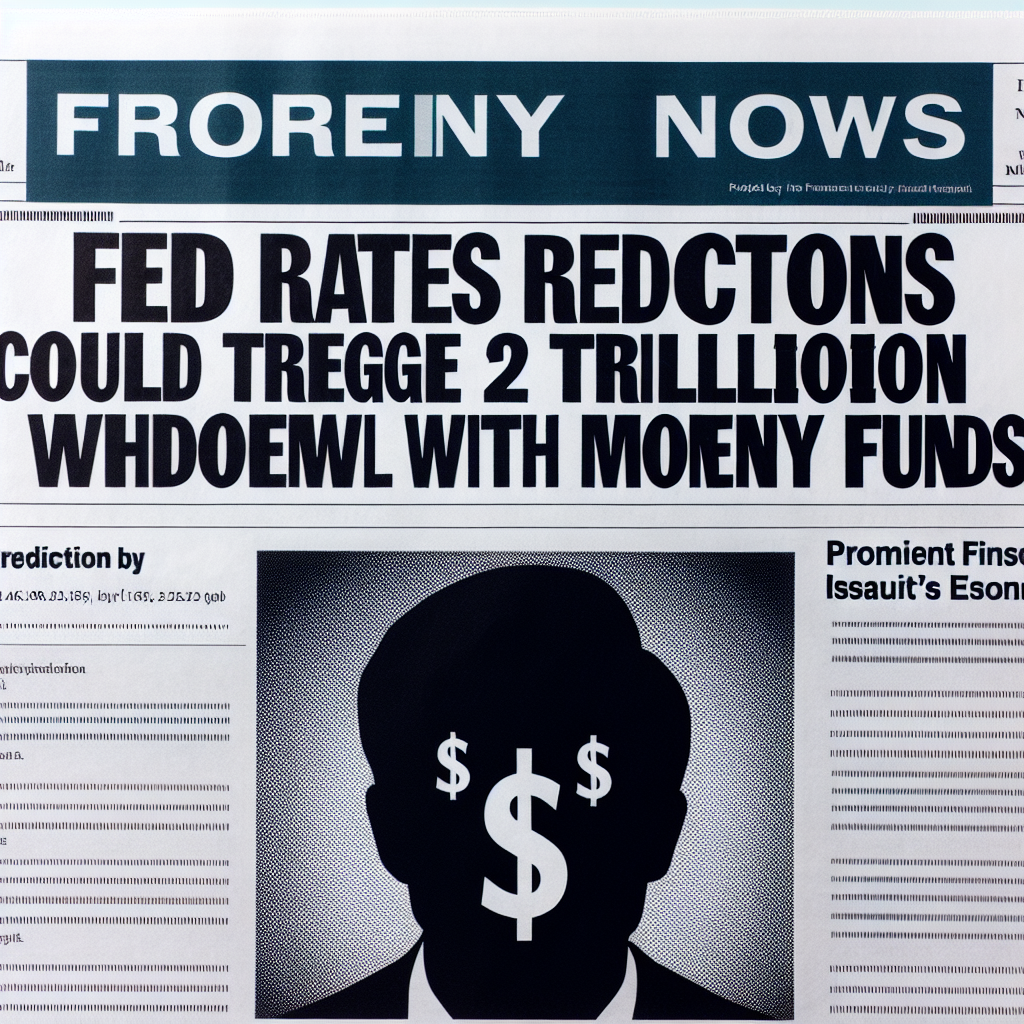“Fed Rate Cuts: A $2 Trillion Tidal Wave Looms, Warns Apollo’s Slok”
Introduction
In a recent analysis, Apollo’s chief economist, Torsten Slok, has projected that potential reductions in the Federal Reserve’s interest rates could lead to a significant outflow of capital from money market funds, estimating withdrawals could reach up to $2 trillion. This prediction underscores the sensitivity of money market funds to changes in interest rates, as investors seek higher returns in alternative assets when rates decline. The anticipated shift could have substantial implications for financial markets, influencing liquidity and investment strategies across various sectors. Slok’s forecast highlights the broader economic impact of monetary policy adjustments and the intricate dynamics between interest rates and investment flows.
Impact Of Fed Rate Reductions On Money Market Funds
The potential for Federal Reserve rate reductions has sparked considerable discussion among financial analysts, with particular attention to the implications for money market funds. According to Torsten Slok, Chief Economist at Apollo Global Management, a significant shift could be on the horizon. Slok predicts that a reduction in the Federal Reserve’s interest rates could lead to a substantial withdrawal of approximately $2 trillion from money market funds. This forecast is rooted in the understanding of how interest rate changes influence investor behavior and the broader financial landscape.
Money market funds, which are mutual funds that invest in short-term, high-quality debt instruments, have long been considered a safe haven for investors seeking stability and liquidity. These funds typically offer higher yields than traditional savings accounts, making them an attractive option when interest rates are elevated. However, when the Federal Reserve opts to reduce interest rates, the yields on these funds tend to decrease, potentially prompting investors to seek alternative investment opportunities that offer higher returns.
The anticipated withdrawal of $2 trillion from money market funds, as suggested by Slok, underscores the sensitivity of these funds to interest rate fluctuations. As rates decline, the appeal of money market funds diminishes, leading investors to reallocate their assets into equities, bonds, or other investment vehicles that may offer better returns in a low-interest-rate environment. This reallocation could have significant ramifications for the financial markets, as the movement of such a large sum of money could influence asset prices and market dynamics.
Moreover, the potential outflow from money market funds could also impact the broader economy. Money market funds play a crucial role in providing short-term financing to corporations and governments by purchasing commercial paper and Treasury bills. A substantial withdrawal could reduce the availability of this short-term financing, potentially leading to tighter credit conditions. This, in turn, could affect businesses’ ability to finance operations and growth, thereby influencing economic activity.
In addition to these direct effects, the anticipated withdrawal from money market funds could also have indirect consequences for financial institutions. Banks and other financial entities that rely on money market funds for liquidity management may face challenges in maintaining their liquidity positions. This could prompt these institutions to adjust their strategies, potentially affecting their lending practices and risk management approaches.
While the prediction of a $2 trillion withdrawal is significant, it is essential to consider the broader context of Federal Reserve policy decisions. The central bank’s actions are typically guided by its dual mandate to promote maximum employment and stable prices. Therefore, any decision to reduce interest rates would likely be driven by economic conditions that warrant such a move. Consequently, the potential impact on money market funds must be weighed against the broader economic benefits that rate reductions might provide.
In conclusion, the prospect of Federal Reserve rate reductions presents a complex scenario for money market funds and the financial markets at large. Torsten Slok’s prediction of a $2 trillion withdrawal highlights the potential for significant shifts in investor behavior and market dynamics. As stakeholders navigate this evolving landscape, it will be crucial to monitor the interplay between interest rate changes, investor responses, and the broader economic environment to understand the full implications of such monetary policy decisions.
Understanding Apollo’s Slok Prediction On $2 Trillion Withdrawal
In recent financial discourse, the prediction by Apollo’s chief economist, Torsten Slok, regarding a potential $2 trillion withdrawal from money market funds has garnered significant attention. This forecast is intricately linked to the Federal Reserve’s anticipated rate reductions, which could set off a chain reaction in the financial markets. To comprehend the implications of Slok’s prediction, it is essential to first understand the current landscape of money market funds and the role of Federal Reserve interest rates.
Money market funds have long been a popular choice for investors seeking a safe haven for their capital. These funds offer liquidity and stability, making them an attractive option during periods of economic uncertainty. However, their appeal is closely tied to the interest rates set by the Federal Reserve. When the Fed raises rates, money market funds typically offer higher yields, drawing in more investors. Conversely, when the Fed reduces rates, the yields on these funds tend to decrease, potentially prompting investors to seek higher returns elsewhere.
Slok’s prediction hinges on the expectation that the Federal Reserve will soon embark on a series of rate cuts. This expectation is rooted in the current economic climate, characterized by slowing growth and persistent inflationary pressures. As the Fed aims to stimulate economic activity, it may opt to lower interest rates, thereby reducing the attractiveness of money market funds. Consequently, investors may begin to withdraw their capital in search of more lucrative opportunities, such as equities or other fixed-income securities.
The potential withdrawal of $2 trillion from money market funds is not merely a theoretical exercise; it carries significant implications for the broader financial system. A mass exodus of this magnitude could lead to increased volatility in financial markets, as investors reallocate their assets. Moreover, it could impact the liquidity of money market funds themselves, potentially forcing them to sell off assets to meet redemption requests. This scenario could create a ripple effect, affecting the stability of short-term funding markets and, by extension, the broader economy.
Furthermore, the anticipated shift in investor behavior underscores the delicate balance that the Federal Reserve must maintain in its monetary policy decisions. While rate cuts may be necessary to support economic growth, they also carry the risk of destabilizing certain segments of the financial market. The Fed must carefully weigh these considerations as it navigates the complex economic landscape.
In addition to the immediate financial implications, Slok’s prediction also highlights the evolving nature of investor preferences and the increasing importance of strategic asset allocation. As traditional safe havens like money market funds become less attractive in a low-rate environment, investors may need to reassess their portfolios and explore alternative investment strategies. This shift could lead to increased demand for financial advisory services and a greater emphasis on diversification.
In conclusion, Torsten Slok’s prediction of a $2 trillion withdrawal from money market funds serves as a stark reminder of the interconnectedness of monetary policy and financial markets. As the Federal Reserve contemplates rate reductions, the potential consequences for money market funds and the broader financial system cannot be overlooked. Investors, policymakers, and financial institutions alike must remain vigilant and adaptable in the face of these evolving dynamics, ensuring that they are well-prepared to navigate the challenges and opportunities that lie ahead.
Historical Analysis Of Fed Rate Cuts And Money Fund Withdrawals
The relationship between Federal Reserve rate cuts and money fund withdrawals has long been a subject of interest for economists and financial analysts. Historically, changes in the Federal Reserve’s interest rates have had significant implications for various financial instruments, including money market funds. These funds, which are typically considered low-risk investments, often attract investors seeking stability and modest returns. However, when the Federal Reserve reduces interest rates, the dynamics of these investments can shift dramatically.
To understand the potential impact of future rate cuts, it is essential to examine past instances where similar monetary policy actions have led to substantial withdrawals from money market funds. Historically, when the Federal Reserve lowers interest rates, the yields on money market funds tend to decrease. This reduction in yield can make these funds less attractive to investors, who may then seek higher returns elsewhere. Consequently, significant outflows from money market funds can occur as investors reallocate their assets to more lucrative opportunities.
For instance, during the financial crisis of 2008, the Federal Reserve implemented a series of aggressive rate cuts to stimulate the economy. As a result, money market fund yields plummeted, prompting a wave of withdrawals as investors sought better returns in other asset classes. This historical precedent underscores the potential for substantial outflows from money market funds in response to rate cuts, as investors adjust their portfolios to align with the changing interest rate environment.
Moreover, the current economic landscape adds another layer of complexity to this dynamic. With inflationary pressures and economic uncertainties persisting, the Federal Reserve’s monetary policy decisions are under intense scrutiny. Should the Fed decide to reduce rates in the near future, it could trigger a significant shift in investor behavior. Apollo’s Slok predicts that such a scenario could lead to a staggering $2 trillion withdrawal from money market funds. This prediction is grounded in the understanding that investors, faced with diminishing returns on these traditionally safe investments, may opt to explore alternative avenues that promise higher yields.
Furthermore, the potential for large-scale withdrawals from money market funds raises concerns about the broader financial system’s stability. A sudden and massive reallocation of assets could lead to increased volatility in financial markets, as investors move their capital into riskier investments. This shift could have ripple effects across various sectors, impacting everything from stock prices to bond yields. Therefore, it is crucial for policymakers and financial institutions to closely monitor these developments and prepare for potential market disruptions.
In conclusion, the historical analysis of Federal Reserve rate cuts and their impact on money fund withdrawals provides valuable insights into the potential consequences of future monetary policy decisions. As Apollo’s Slok predicts, a significant reduction in interest rates could lead to a $2 trillion withdrawal from money market funds, driven by investors seeking higher returns in a low-yield environment. This scenario underscores the importance of understanding the intricate relationship between interest rates and investor behavior, as well as the need for vigilance in navigating the potential challenges that may arise in the financial markets. By examining past trends and considering current economic conditions, stakeholders can better anticipate and respond to the evolving landscape of monetary policy and its implications for money market funds.
Strategies For Investors Amid Potential Money Fund Withdrawals

As the financial landscape continues to evolve, investors are closely monitoring the potential implications of the Federal Reserve’s monetary policy decisions. Recently, Apollo’s chief economist, Torsten Slok, has predicted that a reduction in the Federal Reserve’s interest rates could lead to a significant withdrawal of approximately $2 trillion from money market funds. This forecast has prompted investors to reassess their strategies, as the anticipated outflow could have far-reaching effects on various asset classes and the broader economy.
To understand the potential impact of such a substantial withdrawal, it is essential to consider the role of money market funds in the financial ecosystem. These funds are typically seen as safe havens for investors seeking liquidity and stability, offering modest returns in exchange for lower risk. However, when interest rates decline, the attractiveness of these funds diminishes, prompting investors to seek higher yields elsewhere. This shift in investor behavior could lead to a reallocation of capital across different asset classes, thereby influencing market dynamics.
In light of this potential scenario, investors may need to adopt a more proactive approach to portfolio management. One strategy could involve diversifying investments to include a mix of equities, bonds, and alternative assets. By doing so, investors can potentially mitigate the risks associated with a concentrated exposure to money market funds. Moreover, diversification can provide a buffer against market volatility, which may arise as a result of large-scale capital movements.
Additionally, investors might consider increasing their exposure to equities, particularly those with strong fundamentals and growth potential. Historically, equities have outperformed other asset classes during periods of low interest rates, as companies benefit from reduced borrowing costs and increased consumer spending. However, it is crucial for investors to conduct thorough research and select stocks with robust financial health and competitive advantages to maximize returns.
Furthermore, fixed-income securities could also play a vital role in an investor’s strategy amid potential money fund withdrawals. While traditional bonds may offer lower yields in a declining interest rate environment, investors could explore opportunities in high-yield bonds or emerging market debt, which may provide more attractive returns. It is important, however, to carefully assess the credit risk associated with these investments to avoid potential pitfalls.
In addition to traditional asset classes, alternative investments such as real estate, commodities, and private equity may offer diversification benefits and potential for higher returns. These assets often exhibit low correlation with traditional markets, making them valuable additions to a well-rounded portfolio. However, investors should be mindful of the unique risks and liquidity constraints associated with alternative investments.
As the possibility of a $2 trillion withdrawal from money market funds looms, investors must remain vigilant and adaptable. By employing a diversified investment strategy and staying informed about market trends, they can better navigate the challenges and opportunities that may arise. Ultimately, the key to successful investing in this environment lies in maintaining a long-term perspective and being prepared to adjust strategies as economic conditions evolve. Through careful planning and strategic allocation, investors can position themselves to weather potential market disruptions and achieve their financial objectives.
The Role Of Interest Rates In Money Market Fund Stability
Interest rates play a pivotal role in the stability and attractiveness of money market funds, serving as a key determinant of investor behavior and fund performance. As the Federal Reserve adjusts its interest rate policies, the ripple effects are felt across various financial instruments, including money market funds. These funds, which are typically seen as low-risk investment vehicles, offer investors a place to park their cash while earning a modest return. However, the dynamics of these funds can shift dramatically in response to changes in interest rates.
Recently, Apollo’s chief economist, Torsten Slok, has predicted that a reduction in the Federal Reserve’s interest rates could lead to a significant withdrawal of funds from money market accounts, potentially amounting to $2 trillion. This forecast underscores the sensitivity of money market funds to interest rate fluctuations. When the Federal Reserve lowers rates, the yields on money market funds tend to decrease, making them less attractive to investors seeking higher returns. Consequently, investors may be inclined to move their capital to alternative investment opportunities that promise better yields, such as equities or bonds.
The potential for such a massive outflow of funds highlights the delicate balance that money market funds must maintain in order to remain competitive. These funds rely heavily on short-term interest rates to generate returns for their investors. When rates are high, money market funds can offer attractive yields, drawing in more investors. Conversely, when rates fall, the returns diminish, prompting investors to reconsider their allocations. This dynamic is particularly pronounced in the current economic climate, where the Federal Reserve’s monetary policy decisions are closely watched by market participants.
Moreover, the implications of a large-scale withdrawal from money market funds extend beyond the funds themselves. A sudden and substantial outflow of capital could lead to liquidity challenges, as these funds may struggle to meet redemption requests without selling off assets at unfavorable prices. This scenario could potentially disrupt the broader financial markets, as money market funds are significant players in the short-term funding markets. They provide essential liquidity to corporations and governments by purchasing commercial paper and Treasury bills, among other instruments.
In light of these considerations, it is crucial for both investors and fund managers to closely monitor the Federal Reserve’s policy signals and prepare for potential shifts in the interest rate landscape. Investors should assess their risk tolerance and investment objectives, ensuring that their portfolios are well-positioned to weather changes in interest rates. Fund managers, on the other hand, must remain vigilant in managing their portfolios, balancing the need for liquidity with the pursuit of yield.
In conclusion, the prospect of a $2 trillion withdrawal from money market funds, as predicted by Apollo’s Slok, serves as a stark reminder of the intricate relationship between interest rates and money market fund stability. As the Federal Reserve navigates its monetary policy path, the decisions it makes will have far-reaching consequences for these funds and the broader financial ecosystem. By understanding the role of interest rates in shaping investor behavior and fund performance, stakeholders can better anticipate and respond to the challenges and opportunities that lie ahead.
Comparing Past And Present Fed Rate Reduction Scenarios
In the complex world of finance, the Federal Reserve’s decisions on interest rates are pivotal, influencing a wide array of economic activities. Historically, changes in the Fed’s rate have had significant impacts on financial markets, consumer behavior, and institutional strategies. The current discourse, as highlighted by Apollo’s chief economist Torsten Slok, revolves around the potential consequences of future Fed rate reductions, particularly the possibility of a $2 trillion withdrawal from money market funds. To understand the implications of such a scenario, it is essential to compare past and present Fed rate reduction scenarios, examining how they have shaped economic landscapes and investor behavior.
In previous instances of rate reductions, the Federal Reserve typically aimed to stimulate economic growth by making borrowing cheaper, thereby encouraging spending and investment. For example, during the financial crisis of 2008, the Fed aggressively cut rates to near zero, a move that was instrumental in stabilizing the economy. This period saw a significant shift in investor behavior, as lower yields on traditional savings accounts and money market funds prompted a search for higher returns in riskier assets such as stocks and corporate bonds. Consequently, the stock market experienced a robust recovery, while money market funds saw substantial outflows as investors reallocated their portfolios.
Fast forward to the present, the economic environment is markedly different. The COVID-19 pandemic and subsequent recovery efforts have led to unprecedented fiscal and monetary interventions. As the economy navigates through post-pandemic challenges, the Fed’s interest rate policies remain a focal point. Currently, money market funds are attractive to investors due to their relatively higher yields compared to the past decade, driven by the Fed’s rate hikes to combat inflation. However, should the Fed decide to reduce rates in response to changing economic conditions, the dynamics could shift dramatically.
Slok’s prediction of a potential $2 trillion withdrawal from money market funds underscores the sensitivity of these funds to interest rate changes. A reduction in rates would likely decrease the yields on money market funds, making them less appealing to investors seeking returns. This scenario could mirror past trends where investors moved their capital into equities and other higher-yielding assets, seeking to maximize returns in a low-interest-rate environment. The potential outflow from money market funds could have broader implications for financial markets, influencing liquidity and asset prices.
Moreover, comparing past and present scenarios reveals that the current economic context is influenced by additional factors such as geopolitical tensions, supply chain disruptions, and evolving consumer behaviors. These elements add layers of complexity to the Fed’s decision-making process and the subsequent market reactions. While historical patterns provide valuable insights, the unique challenges of today’s global economy necessitate a nuanced understanding of how rate reductions might play out.
In conclusion, the prospect of Fed rate reductions and their impact on money market funds is a multifaceted issue that requires careful consideration of historical precedents and current economic conditions. As investors and policymakers navigate this landscape, the lessons from past rate reduction scenarios offer guidance, yet the distinct characteristics of today’s economy demand a forward-looking approach. The potential $2 trillion withdrawal from money market funds, as predicted by Slok, serves as a reminder of the intricate interplay between monetary policy and market dynamics, highlighting the need for strategic foresight in an ever-evolving financial environment.
Implications Of Large-Scale Withdrawals On Financial Markets
The potential for significant shifts in financial markets is a topic of considerable interest, particularly when it involves large-scale movements of capital. Recently, Apollo’s chief economist, Torsten Slok, has predicted that a reduction in the Federal Reserve’s interest rates could lead to a substantial withdrawal of approximately $2 trillion from money market funds. This forecast raises important questions about the implications such a withdrawal could have on financial markets and the broader economy.
To understand the potential impact, it is essential to first consider the role of money market funds. These funds are a popular investment vehicle, offering liquidity and a relatively safe place for investors to park their cash. They typically invest in short-term, high-quality debt instruments and are often used by both individual and institutional investors as a means of managing cash flow. The attractiveness of these funds is closely tied to prevailing interest rates; when rates are high, money market funds offer competitive returns. However, when the Federal Reserve reduces interest rates, the yields on these funds tend to decrease, making them less appealing to investors seeking higher returns.
In the event of a rate reduction by the Federal Reserve, investors may begin to seek alternative investment opportunities that offer better returns. This shift in investor behavior could lead to a significant outflow of capital from money market funds. The predicted $2 trillion withdrawal represents a substantial portion of the assets currently held in these funds, and such a large-scale movement of capital could have several implications for financial markets.
Firstly, the withdrawal of funds from money market accounts could lead to increased volatility in financial markets. As investors move their capital into other asset classes, such as equities or bonds, the sudden influx of funds could drive up prices and create imbalances. This volatility may be exacerbated by the fact that money market funds are often used by institutional investors, whose large transactions can have outsized effects on market dynamics.
Moreover, the outflow of capital from money market funds could impact the broader economy by influencing interest rates and credit availability. Money market funds are significant purchasers of short-term debt instruments, including commercial paper and Treasury bills. A reduction in demand for these instruments could lead to higher borrowing costs for businesses and the government, potentially slowing economic growth. Additionally, if the withdrawal of funds leads to a tightening of credit conditions, it could have a ripple effect on consumer spending and business investment.
Furthermore, the potential for large-scale withdrawals from money market funds highlights the importance of effective risk management strategies for both investors and financial institutions. Investors may need to reassess their portfolios and consider diversifying their investments to mitigate the impact of interest rate changes. Financial institutions, on the other hand, may need to enhance their liquidity management practices to ensure they can meet redemption requests without disrupting their operations.
In conclusion, while the prediction of a $2 trillion withdrawal from money market funds in response to Federal Reserve rate reductions is speculative, it underscores the interconnectedness of financial markets and the potential for significant shifts in investor behavior. As such, it is crucial for market participants to remain vigilant and adaptable in the face of changing economic conditions. By understanding the potential implications of large-scale capital movements, investors and financial institutions can better navigate the complexities of the financial landscape.
Q&A
1. **What is the main prediction made by Apollo’s Slok regarding Fed rate reductions?**
Apollo’s Slok predicts that Fed rate reductions could trigger a $2 trillion withdrawal from money market funds.
2. **Why might Fed rate reductions lead to withdrawals from money market funds?**
Lower interest rates could make money market funds less attractive, prompting investors to seek higher returns elsewhere.
3. **What are money market funds?**
Money market funds are investment vehicles that invest in short-term, high-quality debt instruments and aim to offer high liquidity with a low level of risk.
4. **How significant is a $2 trillion withdrawal from money market funds?**
A $2 trillion withdrawal would be substantial, potentially impacting liquidity and stability in financial markets.
5. **What could investors do with the withdrawn funds?**
Investors might reallocate the withdrawn funds into higher-yielding assets such as stocks, bonds, or other investment opportunities.
6. **What role does the Federal Reserve play in influencing money market funds?**
The Federal Reserve influences interest rates, which directly affect the yields of money market funds and their attractiveness to investors.
7. **What are the potential broader economic implications of such a large withdrawal from money market funds?**
A large withdrawal could lead to increased volatility in financial markets, affect liquidity, and potentially impact the broader economy by shifting capital flows.
Conclusion
Fed rate reductions could potentially lead to a significant withdrawal from money market funds, as predicted by Apollo’s Slok. The expectation is that lower interest rates would make these funds less attractive to investors seeking higher yields, prompting them to move their capital elsewhere. This shift could result in an estimated $2 trillion being withdrawn from money funds. Such a large-scale movement of funds could have broader implications for financial markets, affecting liquidity and potentially leading to increased volatility. The prediction underscores the sensitivity of money market funds to interest rate changes and highlights the potential impact of monetary policy decisions on investment behavior.





